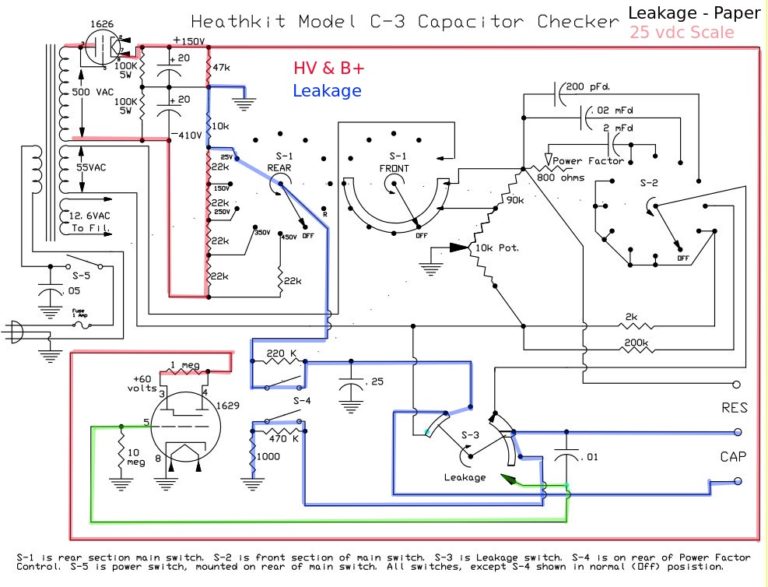Heathkit C3 Condenser Checker – How it Works Part 3
Heathkit C3 Condenser Checker – How it Works Part 3
In Part 1 of this series of posts, I introduced the Heathkit C3 Condenser Tester Wheatstone Bridge operation.
In Part 2, we traced out the schematic of the Resistance and Capacitance measurements.
Here in Part 3, we will delve into the Leakage Test function of the tester.
The Leakage test operates by placing a selectable DC voltage across the capacitor under test. For large electrolytic caps, a couple of series resistors are added to limit the surge current when the voltage is applied for the test. For smaller capacitors, the voltage is applied straight to the device under test.
In the diagram above, you can see that the high voltage winding of the transformer at the top left of the diagram is rectified by the 1626 tube, resulting in about 500 vdc. This voltage is split into two sections where the chassis ground is connected between the 47K source resistor and the first voltage divider resistor of 10K.
Switch S1 (rear) selects voltages of 25, 150, 350 or 450 vdc. For small capacitors, switch S4 (paper/mica vs electrolytic) is closed, allowing the selected voltage to continue unimpeded to switch S3 (leakage). When switch S3 is rotated clockwise, the voltage is applied to one of the banana jacks for the capacitor under test.
The other side of the capacitor is connected through the still rotated switch S3 to a second section of switch S4, which is still closed, bypassing a second current limiting resistor. The connection is then through the 1000 ohm resistor to chassis ground.
For large electrolytic style capacitors, switch S4 is set to the “ELEC” position, which places a 470K and a 220K resistor in series with the charge path. This limits the charging current when the high voltage is applied to the capacitor. In either case,the metering is accomplished by sampling the dc voltage from the middle banana jack, and watching the action of the Eye Tube. The Eye should rapidly close, then open to the starting position quickly. If it doesn’t open wide enough, or is slow to open, the capacitor is leaky.
In either case (paper/mica vs electrolytic), when S3 is released, a spring returns it to the original position, and places a 2K resistor directly across the capacitor under test, providing a discharge path.
Heathkit Electrolytic Leakage Diagram
Heathkit Paper/Mica Leakage Diagram
Check back for a post to show the refurbishment of the tester after the parts have been received.
Migrated Comments:
4 Responses to “Heathkit C3 Condenser Checker – How it Works Part 3”









February 20th, 2019 at 12:07 pm
First thank you very much for sharing this as there is nothing
else like it available. I am a 66 year old guitarist and I repair
my old tube amps and occasionally my friends. I just got a Heathkit C-3 and have a question. I have a new production but five year old
USA made cap can with 30 30 30 10 caps.They show very low ESR and
correct capacitance. I did a leakage test and the eye tube opens
wider on say 150v than on 450v.The eye opens quickly and firmly.I
had a local shop form them up and test them last week before getting
my Heathkit and they said they were fine and did not leak.The C-3
has been refurbished and tested – is there a leakage problem?
February 20th, 2019 at 9:15 pm
Hi William. With the testing you have performed on the capacitor, I would be confident in using it. It doesn’t appear to have any problems. I haven’t really paid much attention to how far the eye opens up at the different voltages, but if it swings back quickly, as you say, I would consider it to have very little leakage.
Good luck in your projects… Randy wb0smx
April 4th, 2019 at 6:37 am
Hi, my dad built one of these. I still have it. Not sure if it’s working. Does anyone know what year these came out? 1950s, 1960s? Thanks, Todd
April 10th, 2019 at 7:52 am
I see it in Heathkit catalogs going back to 1956. So I would say early to mid 50’s.